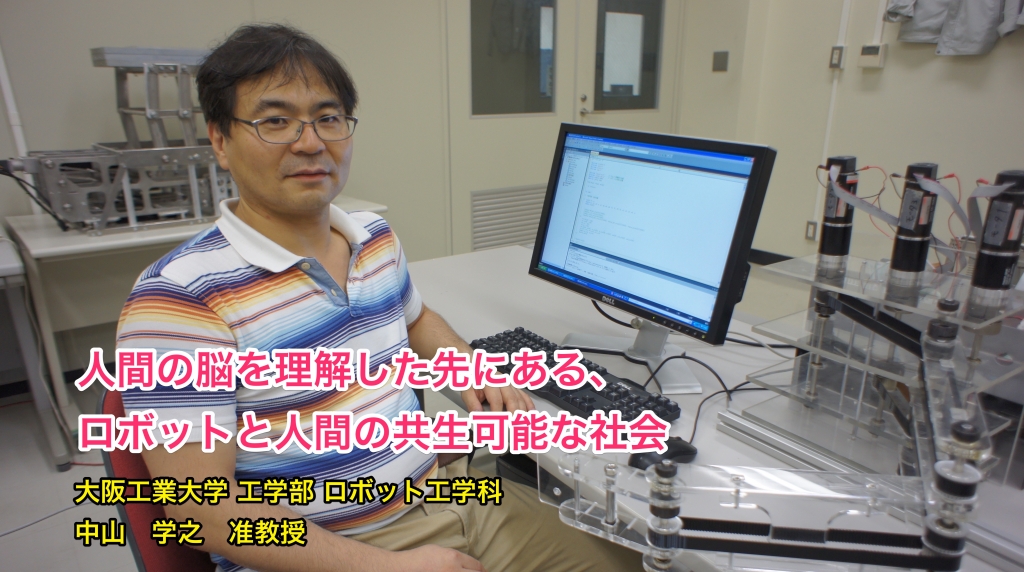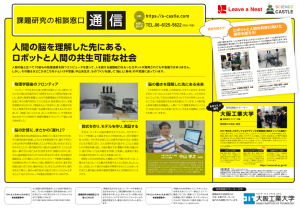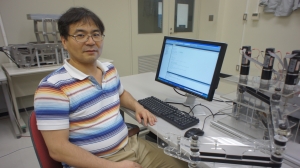- Notice
- over the counter communication
- Consultation Service for Proposed Research
Issue Research Consultation News Letter (February 23, 2016) Beyond Understanding the Human Brain: A Society Where Robots and Humans Can Live Together
2017.02.23
.
The PDF file is in poster format for easy posting! Please download it!
Issue Research Consultation Service News Letter vol.5 Dr. Nakayama (4589 downloads)

It would not be surprising if a computer with a processing speed 10 times faster than the human brain could be used to develop a robot with motor capabilities that surpass those of humans. However, it is a wonder that their movements are somewhat awkward. Dr. Nakayama is exploring the mysteries of the "brain" and "body" through manufacturing.
The Last Frontier of Physics
Around the time computers were invented, research began on how to realize the mechanism of what humans call the "brain" in terms of processing and memory. While researching in the field of mathematical engineering, which is based on mathematics and physics, and which investigates information theory, he came to believe that, in order to understand the essence of the brain, "it is necessary to create a form based on a theory and investigate whether the intended movements can be reproduced properly. He began to challenge the "brain," the final frontier of physics, from the viewpoint of manufacturing.
Brain calculations, no way "delayed"!
The basic neural response to movement is the stretch reflex, in which the muscle itself tries to contract when a pulling force is applied to it. You may have experienced the phenomenon of a shin lift when you tap below the knee, which is exactly the result of some muscles being pulled by the tap. Such a reflex seems to happen in an instant, but in reality it takes 30 milliseconds, and even 100 milliseconds via the brain. The professor's original point of view is this "delay. Computer control of robots usually performs this process in as little as 1 millisecond, but processing that is too fast can result in awkward movements. Our smooth movement is achieved by introducing the delay and controlling it with the "cerebellum," a part of the brain.
Create formulas, build models, and demonstrate
The professor immediately began modeling the workings of the cerebellum and demonstrating them through computer control. He began to model the workings of the cerebellum, and then began to demonstrate this model by computer control. He asked himself what signals would be sent when a phenomenon occurred, what signals would be sent when triggered, and what signals would be sent back when processed according to what equations. Through repeated testing of these hypotheses, he demonstrated that the cerebellum's key function is to "predict motion," and that even if there is a delay, the cerebellum can predict and control future motion, resulting in smooth movement.
In fact, a door-opening robot developed using this method has succeeded in reproducing smooth, human-like movements. However, it may not be able to reproduce smooth movements under certain circumstances, and it will still take time to understand how the human brain and body work together.
The future beyond understanding how the brain works
I have been doing this research for 15 years since graduate school, but there is still so much I don't know," he says. However, the sense of accomplishment he feels when he hits upon a hypothesis that he does not understand and it turns out to be correct is what motivates him. His challenge to "create something useful for society by reconstructing the function of the human brain and body and deepening our understanding of human beings" will continue in the future.
 |
| Department of Robotics, Faculty of Engineering, Osaka Institute of Technology Associate Professor Gakuyuki Nakayama left the University of Tokyo in 2000 after earning doctoral credits at the Graduate School of Engineering, and became a researcher at the RIKEN Biomimetic Control Research Center in the same year, and in 2006 became an assistant professor, specially appointed associate professor, and specially appointed professor in the Omohi area, Graduate School of Engineering, Nagoya Institute of Technology, before assuming his current position (Ph. ); scheduled to move to the Department of System Design Engineering, Faculty of Robotics & Design Engineering, Osaka Institute of Technology, in April 2017. |
<Let's use it! What is the consultation service for research issues?
This is a new service in which RIVERNESS and researchers from universities and companies will answer questions and concerns that arise in your daily research activities. Please feel free to apply. (To use this service, you need to log in to Teachia.)
For more information, click here:https://s-castle.com/madoguchi/
Research Practice Partner Universities
Manufacturing DivisionOsaka Institute of Technology
| Teachers who have registered as "Education Support Teachers" will receive the latest Science Bridge News every Tuesday as a PDF file edited into an easy-to-use wall newspaper format for use in schools. For more details, please click here ⇒.Science Bridge News for School |
.
The PDF file is in poster format for easy posting! Please download it!
Issue Research Consultation Service News Letter vol.5 Dr. Nakayama (4589 downloads)

